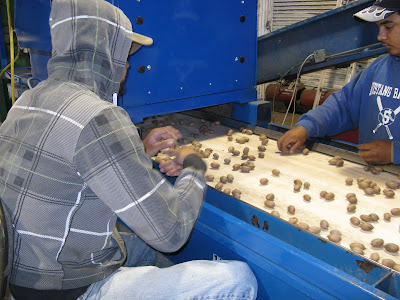1. Eliminate Deadwood! This is a strange thing to say but so appropriate. This actually comes from an editorial written in American Fruit Grower by David Eddy but I also wrote something similar for American Fruit Grower back in 2010. The point is that too much of an orchard manager's time is spent in taking care of the parts of the orchard that will never be above average. Instead, try focussing time and resources managing the already above average areas of your orchard. It is almost certain that every dollar or every minute of time you spend on this productive part of the orchard will yield double what you invest. Also, if we are over-producing low quality pecans, and we are, then why not eliminate completely those areas that consistently produce low yield, low quality pecans almost every year.
2. Hedge, Hedge, Hedge! A recent article in Pecan South magazine by Dr. Lenny Wells makes the point very well indeed. His article title was, "Make the Most of Hedge Pruning in the Southeast." This title will cause Western Growers to just ignore the advice or to maybe even say I'm already doing that. The problem is we are not doing it well and/or enough. Hedging improves consistency of the crop, quality of the pecans, and overall size. I could go into a lot of details here but his article says it all. This picture is one I found on the internet and is beautiful. It shows the kind of hedging we are talking about.
3. Don't Marry Those Trees, Don't Even Date Those Trees! I know this is a tough one for everybody but these trees have a life and for some varieties that life needs to end. Some varieties or even some specific trees are just not productive anymore and need to go. See #1 again. There are many, very productive acres that are covered in nothing but junk and yet we continue to prune, spray and harvest something that is out of date and poor quality. We have varieties that are scab resistant, have better insect resistance, don't overbear like other varieties that have to be thinned, etc, etc. Sharpen that chainsaw and selectively remove or just push down whole rows and definitely, in this difficult economic time, make room and get ready for better times.

4. Lower Your Inputs! This is one of those topics that includes so much but let's identify a just a few. I can hardly go in an orchard that doesn't have some irrigation problems. Leaky valves, bad drip tubing, stopped up emitters and more, are all creating huge problems for trees. Do things on time, is something we all need to hear. Fertilizer applied late is usually not effective and a missed fertilizer application means missed opportunity. Scout and use disease and insect thresholds versus making sprays just because it's time or everyone else is spraying. Last, take those soil and tissue tests and use them for good decisions - don't just guess.
5. Fix Your Sprayer and Fix Your Sprays! There is probably no more important piece of equipment than your sprayer. They need to be calibrated every year to ensure accuracy. Tips wear out and need to be replaced. Even fan blades can wear down and not put out the volume of air like before. Agitation can be a problem with plugged lines. Slow down as trees get thicker and thicker with leaves. Get some help to see if the spray is going through the trees and into the next row. Check the height of spray and maybe go back to No. 2 and hedge tree height back! Why spend the money on tree sprays if you put them in a sprayer that doesn't work right. What about the chemicals and fertilizers you are using - are they any good? Are they outdated, has resistance become an issue, are there better fertilizers that get to issues quicker, are there new and better biologicals as that industry grows every day? Question what you are using, ask yourself why before you put anything in the tank!
6. Improve Your Harvest Quality! This is not an easy fix, but with current pecan prices can pay big dividends. Keep your varieties separate, don't harvest and mix varieties. Keep your pecan nut sizes together. Buyers want the pecans to look uniform. Keep quality with quality. Crank down on the blower and remove those light pecans. The same variety, the same size and the same quality brings the highest prices - always.
7. Improve Your Marketing Plan! I am assuming if you are reading this that you live in Texas. If you grow and sell pecans in Texas you are in the best location in the world to sell pecans (see #6 above first). Texas is a great marketing brand. Anything Texas sells and people the world over want things from Texas and you are growing Texas Pecans. Second, you are selling the only commercially sold native nut in the US. People love to buy native products, American products, and pecans are truly Made in America! Third, you are a Texas Pecan Farm Family. People love knowing where the product is coming from and the people who grow it. Highlighting that fact to consumers sells pecans. Put them all together, Texas - Native Nut - Pecan Farm Family, and almost all consumers will buy Texas Pecans grown by Texas Pecan Farm Families every time they can!













